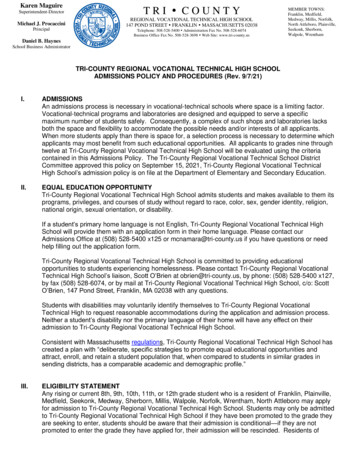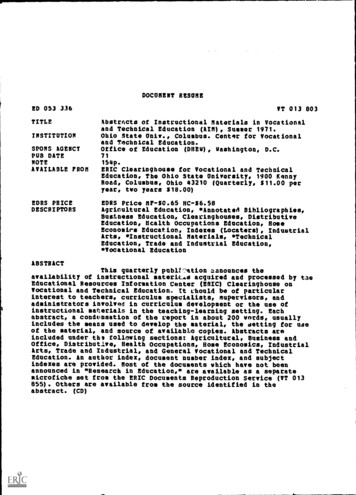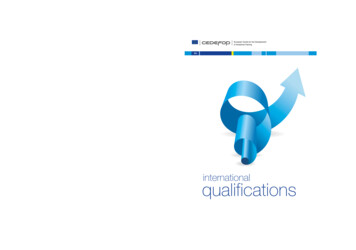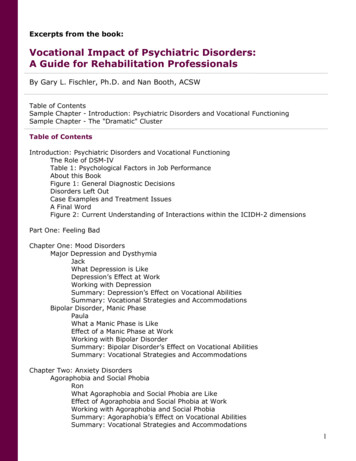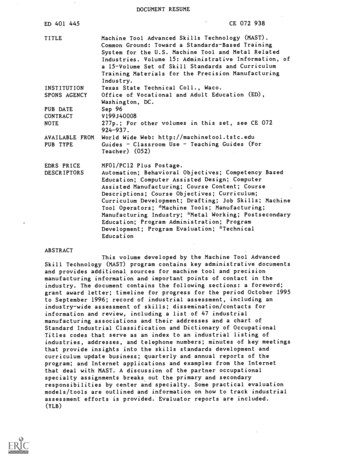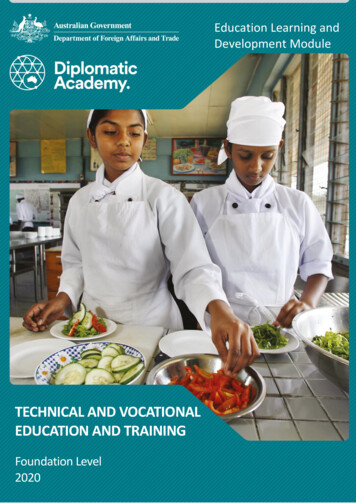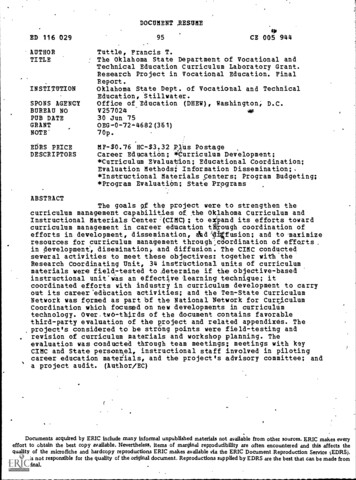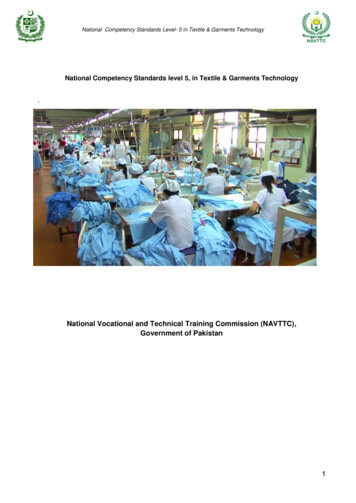
Transcription
National Competency Standards Level- 5 in Textile & Garments TechnologyNational Competency Standards level 5, in Textile & Garments Technology National Vocational and Technical Training Commission (NAVTTC),Government of Pakistan1
National Competency Standards Level- 5 in Textile & Garments TechnologyACKNOWLEDGEMENTSNational Vocational and Technical Training Commission (NAVTTC) extends its gratitude and appreciation to many representatives of business, industry, academia, government agencies, Provincial TEVTAs, Sector Skill Councils and trade associations who speared their time and expertise tothe development and validation of these National Vocational Qualifications (Competency Standards, Curricula, Assessments Packs and related material). This work would not have been possiblewithout the financial and technical support of the TVET Sector Support Programme co-funded byEuropean Union, Norwegian and German Governments implemented by GIZ Pakistan. NAVTTC isespecially indebted to Dr. Muqeem ul Islam, who lead the project from the front. The core teamwas comprised on: Dr. Muqeem ul Islam, Director General (Skills,Standards and Curricula) NAVTTC Mr. Muhammad Naeem Akhtar, Senior Technical Advisor TSSP-GIZ, Mr. Muhammad Yasir, Deputy Director (SS&C Wing) NAVTTC Mr. Muhammad Ishaq, Deputy Director (SS&C Wing) NAVTTC Mr. Fayaz A. Soomro, Deputy Director (SS&C Wing) NAVTTCNAVTTC team under the leadership of Dr. Muqeem ul Islam initiated development of CBT & Abased qualifications of diploma level-5 as a reform project of TVET sector in November 2018 andcompleted 27 NVQF diplomas of Level-5 in September, 2019. It seems worth highlighting that during this endeavor apart from developing competency standards/curricula in conventional tradesnew dimensions containing high-tech trades in TVET sector in the context of generation IR 4.0trades have also been developed which inter alia includes Robotics, Mechatronics, artificial intelligence, industrial automation, instrumentation and process control. Moreover, trades like entrepreneurship, green/environmental skills and variety of soft/digital skill have also been developed toequip the Pakistani youth with skills set as per requirement of the global trends. These skills havebeen made integral part of all the 27 diplomas.Nobody has been more important in the pursuit of this project than Dr. Nasir Khan, Executive Director, NAVTTC, whose patronage and support remain there throughout the development processand lastly to thanks specially to Syed Javed Hassan, Chairman NAVTTC and Raja Saad Khan,Deputy Team Lead TSSP-GIZ who made it happened in this challenging time.2
National Competency Standards Level- 5 in Textile & Garments TechnologyTable of Contents1. Introduction. 62. Purpose of the Qualification . 83. Competencies in Qualification . 94. Date of Validation . 115. Date of Review . 116. Codes of Qualifications. 127. Members of Qualifications Development Committee . 138. Members of Qualifications Validation Committee . 139. Entry Requirements . 1410. Categorization and Levelling of the Competency Standards . 1511. Detail of Competency Standards . 1911.1Textile Fashion designing .190723-T-1. Textile Technology . 190723-T-2. Develop fashion mood board. 200723-T-3. Perform engineering drawing . 210723-T-4. Perform Fashion Sketches . 220723-T-5. Perform basic drape ability through mannequin. 220723-T-6. Develop Fashion Presentation Techniques . 2410.2.Product Development .250723-T-7. Perform garment measurements . 250723-T-8. Design the flat pattern/garment . 260723-T-9. Draft basic Articles . 270723-T-10. Draft the semi fashion articles . 280723-T-11. Draft fashion articles . 290723-T-12. Operate software for digitizing and grading patterns . 320723-T-13. Spread and cut the Fabric . 340723-T-14. Embroidery. 360723-T-15. Estimate Materials . 3810.3.Sewing .400723-T-16. Maintain Safety . 400723-T-17. Set sewing machine as per requirement. 430723-T-18. Operate sewing machine. 440723-T-19. Maintain sewing machine. . 460723-T-20. Identify various stitch and seam . 480723-T-21. Prepare different Garment articles. 503
National Competency Standards Level- 5 in Textile & Garments Technology0723-T-22. Prepare advance articles. 520723-T-23. Identify Best Lean Tools/Principles. 550723-T-24. Implement Time and Motion study. 570723-T-25. Carryout Basic Electrical AC Installation . 590723-T-26. Measure Basic Electrical Units in Series and Parallel Circuits. . 6110.4.Finishing/Pressing .620723-T-27. Diagnose garment faults . 630723-T-28. Control Wastages in a Garment Facility . 650723-T-29. Perform Garment finishes . 670723-T-30. Control garment quality . 690723-T-31. Assure Garments Quality . 710723-T-32. Remove garment faults . 7310.5.Entrepreneurial Skill. .750723-T-33. Apply project information management and communications techniques . 750723-T-34. Apply project human resources management approaches . 760723-T-35. Develop a project management plan . 790723-T-36. Solve problems which jeopardize safety and security . 820723-T-37. Coordinate a work team . 850723-T-38. Lead small teams . 870723-T-39. Plan and organize work . 900723-T-40. Develop teams and individuals . 930723-T-41. Apply problem solving techniques in the workplace using critical thinking . 960723-T-42. Direct human resources management of a project program . 9810.6.Soft Skills. .1010723-T-43. Manage personal work priorities and professional development . 1010723-T-44. Manage workforce planning . 1030723-T-45. Undertake project work . 1060723-T-46. Maintain professionalism in the workplace . 1080723-T-47. Maintain professional development and career professionalism . 1100723-T-48. Organize schedules . 1120723-T-49. Work safely in an office environment . 1140723-T-50. Develop workplace documents. 1160723-T-51. Identify and communicate trends in career development . 11810.7.Digital Skills .1210723-T-52. Install computer operating systems and hardware . 1210723-T-53. Operate digital media technology . 1230723-T-54. Perform computer operations . 1254
National Competency Standards Level- 5 in Textile & Garments Technology0723-T-55. Apply computer applications. 1270723-T-56. Create user documentation . 1290723-T-57. Create technical documentation . 1310723-T-58. Create basic databases. 1320723-T-59. Use social media tools for collaboration and engagement . 1350723-T-60. Use digital devices . 1370723-T-61. Operate word-processing applications . 1390723-T-62. Operate spreadsheet applications . 1410723-T-63. Operate presentation packages . 1430723-T-64. Perform writing and editing tasks. 14511. Complete List of Tools and Equipment . 1475
National Competency Standards Level- 5 in Textile & Garments Technology1. IntroductionPakistan is 4th largest cotton producer (9.5% of the total) and the 3rd largest cotton consumer(10% of the total) in the world. Likewise 2nd largest yarn exporter (26% of the total) and 3rd largestcloth exporter (14% of the total), whereas, in terms of Garment exports and textile exports, Pakistan stands at 20th& 15th rank with only 1% & 2% of the total world shares respectively. (SourceTextile Policy 2014-19). These statistics exhibit that huge benefits are being lost in low value added textile products by exporting the greige fabric or semi manufactured items. The value chain inTextile sector circumferences from raw material production to yarn manufacturing / spinning, fabricweaving, dyeing and finishing, garment sewing, branding, packaging etc. All these supply chainessentials are geographically dispersed across Pakistan. Our neighboring countries have alwaysconsidered Textile Garment exports as their prime component for Economic prosperity and suchreliance on the garments industry for both jobs and export revenues made their populations, veryvulnerable to adverse shifts in socio-economic patternsi. Textile's sector is the mainstay of the country's exports as it accounts for more than half of exports. Its performance has been affected by poor crops, delay in introduction of quality seedand regulatory approval of introduction of Bt cotton, widespread energy shortages, numerouslocal taxes and levies, high cost of finance and restricted trade regimes adopted by importingcountriesii. At present 110 million persons are employed in Pakistan, out of which 13.8 % are in the manufacturing sector. The projected workforce by 2050 is 236 million (Pakistan Education Statistics2010-11). The textile sector employs 38 % of the labor force of manufacturing sector, i.e., approximately about 2.77 millioniii. The annual requirement for trained manpower in the textile manufacturing sector at a minimumof 5 % per annum comes to 135,000. (Economic Survey of Pakistan 2016-2017) The presentavailability of trained manpower in the textile sector is only about 10,000 per annum, Thusthere is a huge gap between supply and demand of skilled work forceiv. The Garment/Clothing segment is the highest value added link in textile value chain. Apparelaccounts for more than 55% of the total value of global textile trade and is consistently growingsince last two decades. (Textile Vision 2005) At present there is a large gap between the requirements of the textile industry and properly trained manpowerv. Besides, There are at least eight different types of Productivity (process and material) lossesin the garments sector: inventory losses (0.92 percent), processing losses (7.57 percent),stitching losses (3.14 percent), packing losses (1.54 percent), re-processing losses (3.6 percent), knitting losses (1.88 percent), cutting losses (5.33 percent), and rejection losses (4 percent).Such losses are mainly due to lack of capacity. Skill enhancement of employees in the6
National Competency Standards Level- 5 in Textile & Garments Technologymaterial and process management can significantly contribute to the profitability of the organization. Obviously, employees with such proven skills will be more likely to have higher wagesleading to improvement production and in their livelihood.Pakistan's future competitiveness depends on productive, high performance workplaces, supported by a highly skilled workforce. In current scenario only those textiles producing countries willsurvive who will adapt to the changing trade environment through a continuous process of skillsdevelopment and modernization, reducing inefficiencies, meeting compliances of internationalstandards development of new products and consolidation, particularly in the value-added subsectors. Since many decades Pakistan has been known in world as raw material and semi processed raw material supplier. Without investment by the Government in vocational training thecurrent position will remain same and there would be no increase in garment exports and also exports mix. The export mix will continue to rely on the exports of yarn and fabric. Its high need oftime that Pakistan should increase its exports of value added garments and biggest strength isthat yarn to fabric every kind of raw material is available in our own country, only world-class highstitching in line with international quality standards is required to convert it into garments.Needs of interventionIn the past a few decades, low public & private cooperation w.r.t. textile policies in purview ofnew emerging global needs resulted severe technological obsolescence, insufficient research &development, unclear path forward and zero concentration towards skill development in textile sector. The Governmental relief policies have also been highly stagnant w.r.t. the textile sector. TextileSector is constantly facing the energy crisis, which is increasing productivity cost and high linelosses. Value added products can never be generated unless a un-interrupted energy source isprovided to this sector. Besides, There are at least eight different types of Productivity (processand material) losses in the garments sector: inventory losses (0.92 percent), processing losses(7.57 percent), stitching losses (3.14 percent), packing losses (1.54 percent), re-processing losses(3.6 percent), knitting losses (1.88 percent), cutting losses (5.33 percent), and rejection losses (4percent).Such losses are mainly due to lack of capacity. Skill enhancement of employees in thematerial and process management can significantly contribute to the profitability of the organization. Obviously, employees with such proven skills will be more likely to have higher wages leadingto improvement production and in their livelihood.Textile sector is suffering low per capita productivity due to significantly deficient skilled manpower.Major economic partners of Pakistan are attaining better outlook, which will have positive impacton the economy of Pakistan, opening wide opportunities for utilization of Pakistani manpower. The7
National Competency Standards Level- 5 in Textile & Garments TechnologyGDP growth accelerates to 4.24 percent in 2014-15 against the growth of 4.03 percent recordedin the same period in 2013-14. Government will provide funds to support the promotion of skillsdevelopment within the textile sector with the aim to improve the country's economic growth andcompetitiveness in the sector. Pakistan's future competitiveness depends on productive, high performance workplaces, supported by a highly skilled workforce. The Garment/Clothing segment isthe highest value added link in textile value chain. Apparel accounts for more than 55% of the totalvalue of global textile trade and is consistently growing since last two decades. (Textile Vision2005) At present there is a large gap between the requirements of the textile industry and properlytrained manpower. Pakistan has got the Generalized System of Preferences (GSP) plus statusfrom January, 2014 from the EU, a move which will provide greater access to Pakistani textileproducts in those markets By Combining the supply side initiatives of shifting toward value addedfinished products through capturing market share foregone by china (as china is phasing out oftextiles and moving more towards manufacturing sector) and acting on Textile policy initiatives withdemand side EU’s GSP trade incentives for Pakistan had opened a big window of opportunity forPakistan to push up its textile exports to the world. For that Pakistan has to well prepare to makemost of the opportunity and unskilled workforce could prove to be a huge impediment in this regard.In order to address this acute shortage of skilled workforce consorted initiative like SDPTI is needof the day. This program will address these challenges to facilitate the growth of this important subsector of economy. As per recent studies the total factor productivity of labor in Pakistan is theleast in South Asia, standing at 1.3, whereas all competitors are better off; despite the fact that thecountry has a booming youth and a positive demographic dividend. These facts warrant respectively that there exists a void in the supply of trained technicians and professionals2. Purpose of the QualificationBased upon this demand of industry these competency‐based qualifications for Textile garmentsTechnology are developed under National Vocational Qualification Framework (Level 1 to 5). Thequalifications mainly cover competencies along with related knowledge and professional attitudewhich is essential for getting a job or self-employed.The qualifications are also in line with the vision of Pakistan’s National Skills Strategy (NSS), National TVET Policy and National Vocational Qualification Framework (NVQF). This provides policydirections, support and an enabling environment to the public and private sectors to impart trainingfor skills development to enhance social and economic profile. The National Vocational & Technical Training Commission (NAVTTC) has approved the Qualification Development Committee8
National Competency Standards Level- 5 in Textile & Garments Technology(QDC) for Textile Garments Technology.The QDC consists of experts from the relevant industriesfrom different geographical locations across Pakistan and academicians who were consulted during the development process to ensure input and ownership of all the stakeholders. The NationalCompetency Standards could be used as a referral document for the development of curricula tobe used by training institutions.The purpose of the training is to provide skilled manpower to improve the quality of value addedproducts of Textile Garments sector. This training will provide the basic skills to the trainees in thefield of Textile Garments stitching and convert it into value added product which is acceptable byInternational market reducing the line losses and fit-in a skilled graduate into National VocationalQualification Framework for his / her vertical career progression and qualification equivalencies atpar with acceptable international standards.3.Competencies in QualificationThe Textile & Garments Technology qualifications level-5 consists of 40% Theory and 60% Practical. The Core competencies of the qualification are as follows:3.1 Textile Fashion designing3.23.1.1Textile Technology3.1.2Develop fashion mood board3.1.3Perform engineering drawing3.1.4Perform Fashion Sketches3.1.5Perform basic drape ability through mannequin3.1.6Develop Fashion Presentation TechniquesProduct Development3.2.1Perform garment measurements3.2.2Design the flat pattern/garment3.2.3Draft basic Article3.2.4Draft the semi fashion articles3.2.5Draft fashion articles3.2.6Operate software for digitizing and grading pattern3.2.7Spread and cut the Fabric3.2.8Embroidery3.2.9Consumption Calculation3.3 Sewing9
National Competency Standards Level- 5 in Textile & Garments Technology3.3.1Maintain Safety.3.3.2Set sewing machine as per requirement3.3.3Operate sewing machine3.3.4Maintain sewing machine3.3.5Identify various stitch and seam3.3.6Prepare different Garment articles3.3.7Prepare advance articles3.3.8Identify Best Lean Tools/Principles3.3.9Implement Time and Motion study3.3.10 Carryout Basic Electrical AC Installation3.3.11 Measure Basic Electrical Units in Series and Parallel Circuits3.4 Finishing/Pressing3.4.1Diagnose garment faults3.4.2Control Wastages in a Garment Facility3.4.3Perform Garment finishes3.4.4Control garment quality3.4.5Assure Garments Quality3.4.6Remove garment faults3.5 Entrepreneurial Skill.3.5.1Apply project information management and communications.3.5.2Apply project human resources management approaches3.5.3Develop a project management plan3.5.4Solve problems which jeopardize safety and security3.5.5Coordinate a work team3.5.6Lead small teams.3.5.7Plan and organize3.5.8Develop teams and individuals3.5.9Apply problem solving techniques in the workplace3.5.10 Direct human resources management of a project program.3.6 Soft Skills.3.6.1 Manage personal work priorities and professional development Manage workforceplanning.3.6.2 Undertake project work.3.6.3 Maintain professionalism in the workplace.3.6.4 Maintain professional development and career professionalism.10
National Competency Standards Level- 5 in Textile & Garments Technology3.6.5 Organize schedules.3.6.6 Work safely in an office environment.3.6.7 Develop workplace documents.3.6.8 Identify and communicate trends in career development.3.6.9 Observe Dress Code3.7 Digital Skills3.7.1Install computer operating systems and hardware.3.7.2Operate digital media technology.3.7.3Perform computer operations.3.7.4Perform computer applications.3.7.5Create user documentation.3.7.6Create technical documentation.3.7.7Create basic databases.3.7.8Use social media tools for collaboration and engagement.3.7.9Use digital devices.3.7.10 Operate word-processing applications.3.7.11 Operate spreadsheet applications.3.7.12 Operate presentation packages.3.7.13 Perform writing and editing tasks.4. Date of ValidationThe level 5 of National DAE qualification on Textile & Garments has been validated by the Qualifications Development Committee (QDC) members on 23 May, 2019 and will remain in currencyuntil May, 20295. Date of ReviewThe level 5 of National DAE qualification on Textile & Garments has been validated by the Qualifications Development Committee (QDC) members on 23 May, 2019 and will remain in currencyuntil May, 202911
National Competency Standards Level- 5 in Textile & Garments Technology6. Codes of QualificationsThe International Standard Classification of Education (ISCED) is a framework for assembling,compiling and analyzing cross-nationally comparable statistics on education and training. ISCEDcodes for these qualifications are assigned as follows:Code0723-T(1)ISCED Classification for Textile & Garments Technician level 5Descriptionst1 Level National Certificate of level-5, in “ Textile & Garments Technology”0723-T(2)0723-T(3)0723-T(4)2nd Level National Certificate of level-5, in “ Textile & Garments Technology”3rd Level National Certificate of level-5, in “ Textile & Garments Technology”4th Level National Certificate of level-5, in “ Textile & Garments Technology”0723-T(5)5th Level National Certificate of level-5, in “ Textile & Garments Technology”12
National Competency Standards Level- 5 in Textile & Garments Technology7.Members of Qualifications Development CommitteeThe following members participated in the qualifications development and validation of 2345*missing8.Members of Qualifications Validation CommitteeThe following members participated in the qualifications development and validation of thesequalifications:S#NameDesignation1Muhammad Imran Ash-Head of Quality De-rafpartment2Dr.Ayyaz ud DinCEOREET Garments Lhr3Mirza Mahmood AkhtarLecturerNational Textile University Fsd.4Muhammad JunaidLecturerPunjab Tianjin University of TechnologySaleemOrganizationInterloop Apparel Pvt,Ltd Fsd.Lhr.5Saadia SyedLecturerP-TEVTA6Qureshia SultanaSr. InstructorP-TEVTA7Rahat yasmeenPrincipleGTVCW Peshawar8Quratulain AineeSr. InstructorS-TEVTA9Amanullah Ch.SROP-BTE Lahore10Engr. Inayat ur RehmenDACUM FasilitatorEx. KP-TEVTA13
National Competency Standards Level- 5 in Textile & Garments Technology9.Entry RequirementsThe entry for D.A. E National Certificate level 5, in Textile & Garments Technology are1. A person having National Vocational Certificate level 4, in Textile & Garments Technology.2. A person having Matric certificate with Science/Arts subjects14
National Competency Standards Level- 5 in Textile & Garments Technology10.cy StandardsCategorization and Levelling of the Competen-1st Semester National Qualification Certificate of level-5, in “Textile & Garments Technology”CodeName of CompetencyLevelCategoryCredit hr3.1.3Perform engineering drawing3Technical43.2.1Perform garment measurements3Technical53.2.33.3.1Draft basic ArticlesMaintain Safety33TechnicalFunctional2103.3.2Set sewing machine as per requirement3Technical93.3.3Operate sewing machine3Technical213.3.53.6.1Identify various stitch and seamManage personal work priorities and professional developmentWork safely in an office environmentObserve Dress CodeInstall computer operating systems and ric1113.6.73.6.103.7.1Total702nd Semester National Qualification Certificate of level-5, in “Textile & Garments Technology”CodeName of Competency/ Duty/ ModuleLevelCategoryCredit hrTechnical23.1.1Textile Technology43.1.3Perform engineering drawing5Technical43.1.43.2.1Perform Fashion SketchesPerform garment measurements44TechnicalTechnical253.2.3Draft basic Articles4Technical33.2.7Spread and cut the .83.7.23.7.73.7.8Operate sewing machineIdentify various stitch and seamDiagnose garment faultsControl Wastages in a Garment FacilityControl garment qualityManage workforce planningDevelop workplace documentsOperate digital media technologyCreate basic databasesUse social media tool
National Competency Standards Level- 5 in Textile & Garments Technology 6 1.Introduction Pakistan is 4th largest cotton producer (9.5% of the total) and the 3rd largest cotton consumer (10% of the total) in the world. Likewise 2nd largest yarn exporter (26% of the total) and 3rd largest
